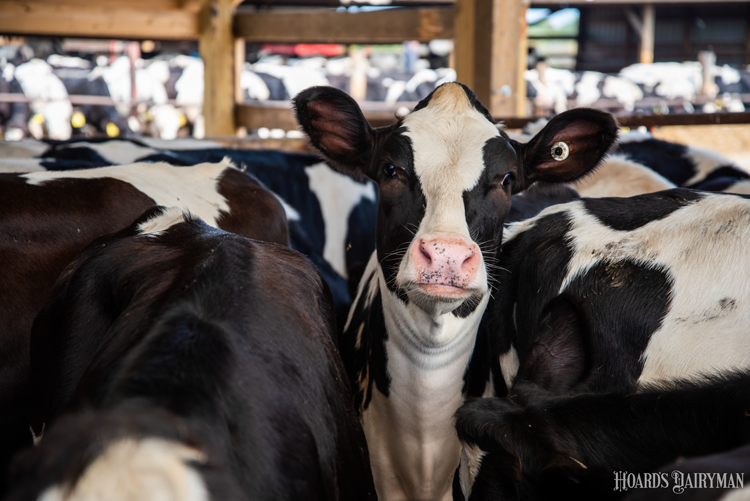
Timely breeding of replacements has long been a goal of competitive dairy producers in order to limit overall days on feed. This key cost metric quantifies the largest expense of rearing replacements. The urge to get heifers settled first service somehow feels increasingly important following the recent USDA announcement of a 20-year low heifer inventory.
In partnership with heifer growers in California, Fabio Lima, a dairy reproduction specialist at the University of California, Davis, explored slight modifications to the existing controlled internal drug release (CIDR) synchronization timed A.I. protocol. This popular protocol has been around for over 10 years and is often used to quickly get semen into well-grown, cycling heifers.
The research looked at adjusting the dose of gonadorelin hydrochloride (GnRH) at the beginning of the protocol. Lima and his team worked with the heifer ranches to enroll 1,300 head to test the impact of using 2 cc or 4 cc of GnRH to induce ovulation.
“This ranch was using a six-day CIDR program to best suit its work environment,” Lima explained on the Dairy Science Digest podcast. “The protocol alteration limited the amount of work employees did on weekends.”
Using the six-day CIDR protocol with 2 cc of GnRH, the ranch was consistently achieving a pregnancy outcome of 58.1% while using sexed semen. However, the research team questioned if these well-grown heifers could benefit from improved ovulation at CIDR insertion through a higher GnRH dose.
Know your synchronization tools
Often, we just automatically deliver the injection of a protocol because the synch sheet printout tells us to — without really thinking about what is happening biologically. Understanding the “why” helps us better appreciate the complex protocol and often helps with compliance.
There are two major structures we are attempting to manipulate on the ovary:
- Corpus luteum (CL): the source of progesterone (hormone of pregnancy) following ovulation
- Follicle: the source of estrogen (hormone of estrus) and what releases the egg or oocyte
Common synchronization tools approved by the Food and Drug Administration (FDA) include:
- CIDR: an intravaginal insert that is a source of progesterone to prevent ovulation
- GnRH: used to induce ovulation and therefore encourage the next wave of follicles
- Prostaglandin (PGF): regresses the CL, allowing estrogen concentration to rise
Using these tools helps producers anticipate when the next ovulation will occur. Popular, research-based protocols are mapped out graphically by the Dairy Cattle Reproduction Council.
It’s common for producers to want to amend these proven protocols to best suit their operations. Sometimes, these changes come in the form of compliance drift, such as administering a treatment in the afternoon rather than the morning. Sometimes, the change is more overt, such as prolonging the CIDR an additional day. Regardless, any changes to the protocol are highly discouraged because subtle alterations can cause big swings in fertility.
Too much progesterone
Is the old adage “Too much of a good thing” possible with progesterone? Yes.
There is a complicated relationship between progesterone and luteinizing hormone (LH) that can impact ovulation rates in dairy animals. LH is produced endogenously by the heifer and released in pulses until it reaches a peak high enough to induce ovulation.
Research has shown that LH is negatively impacted by high progesterone in two ways: the number of pulses and the peak amplitude. Both metrics are reduced by as much as half when circulating progesterone is high. This results in reduced ovulation.
When ovulation doesn’t happen, no egg is released, and therefore, pregnancy cannot happen.
The study ranch’s well-grown heifers commonly had high progesterone levels in the breeding pen. That’s why the research team questioned if the cascade of events required for pregnancy could be improved by doubling the dose of GnRH.
More ovulation but not more pregnancies
The 4 cc treatment of GnRH did boost ovulation rates from 55.6% to 67.7% when compared to the 2 cc treatment. However, this greater ovulation did not improve pregnancy outcomes. “This result surprised us,” said Lima. “Ovulation at the beginning of estrous synchronization is typically a hallmark to achieve pregnancy in such programs.”
The amended protocol, using a six-day CIDR, likely complicated the impact. The response reported is also specific to the scenario — while it didn’t improve pregnancy for the six-day protocol when tested in a five-day CIDR program, a Canadian data set suggests it did improve pregnancy from 63% to 75.9%.
Timing matters. “We’ve learned higher GnRH doses cause ovulation to happen sooner. Heifers show estrus earlier,” described Lima. If breeding is exclusively happening during a scheduled event on Day 9, the follicle that ovulated one day earlier was too old to conceive.
“Cherry-picking” heifers, or using estrus detection to determine when to breed, was not feasible in this research project to accurately assess the impact of the protocol being tested. However, one would speculate cherry-picking would result in breeding during the optimum time relative to ovulation, and therefore might have increased pregnancy.
As a scientist, sometimes it is frustrating to realize that a tested protocol fails to improve fertility. However, it is just as important to report what doesn’t work as it is to report what does work. Land grant universities nationwide conduct research to ensure that dairy producers can make sound business decisions based on reliable data. These decisions will ultimately improve their bottom line.
Be sure to work with your semen dealer or herd veterinarian to implement a research-based protocol in your herd. These research findings were summarized in a peer-reviewed open access Journal of Dairy Science article. To learn more, listen in to the monthly podcast, “Dairy Science Digest,” on your favorite podcast platform.








